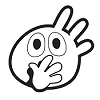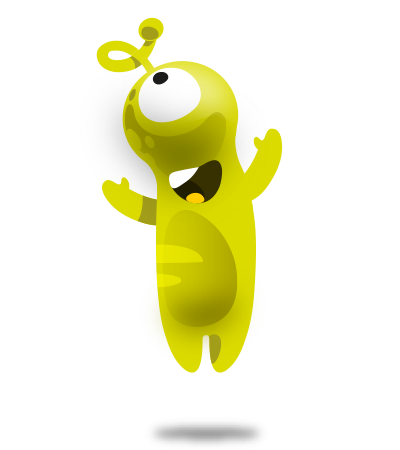The Story
As usual, Tuka is running towards Maco’s house at high speed. She has her sights set on the distant horizon, and almost squashes a tiny, cute snail. But luckily, Tuka notices the terrified creature at the last moment and is able to stretch her foot over the snail. Tuka stops to admire the creature, which stares up at her with big eyes and blinks its long lashes. The lamplight is so dim that it’s extremely dangerous for the snail to be moving around in dusky dawn. Tuka decides to save the snail’s life and lifts the tiny, slimy creature into the palm of her hand. She carefully carries it over to the other side of the road, and places it safely on the ground next to a mailbox. And it was lucky that she did so, because just then someone comes shooting out from behind a large building on a hover board! “I don’t think a little snail knows much about pedestrian crossings and traffic signs!” This is the conclusion that Tuka reaches as she continues on her journey.
The doorbell rings. Unusually, Tuka is the last one to arrive at Maco’s house. The others are already there, sitting in a circle on the living room floor and waiting for her. Maco has been digging through his cupboards and has collected a huge amount of building materials in some large cardboard boxes. “What are we going to do with these? Where shall we start?” Waaba asks happily. Maco has an idea. His superpower always appears when there’s a need for creativity and complex thinking. Maco suggests that they should sort the materials into different stacks according to their geometric shapes. It will then be much easier to form a good picture of the different parts of the machine and start the actual construction.
Waaba is keen to collect all the round and curved shapes, and is already rolling them into a pile. Maco is more systematic, and chooses to stack all of the square shapes. He shares his knowledge by giving the others some more detailed information. His stack will only have shapes whose sides are exactly the same length and whose corners are exactly the same size. Tuka chooses rectangles, because moving them seems to require the most strength – at least, at first glance. Once again, Soca hasn’t had time to choose anything, as he hasn’t been able to get a word out of his mouth. He’s left with triangles. “I wonder if there are any triangular surfaces at all in the pile of materials?” he thinks to himself.
When all of the material in the boxes has been sorted into neat stacks, Tuka starts showing off about the height of her stack. She’s sure that she’s collected the most objects. Maco disagrees with Tuka about the number of items. Waaba suggests that, to solve the problem, everyone should count the number of items in their stack. Maco agrees, and fetches a pen and some squared paper. Everyone should colour in the same number of squares as there are objects in their stack.
To everyone’s surprise, in the middle of the calculation process Maco announces that he’s made a blunder. He has accidentally collected one of Tuka’s rectangles. (Oops! That was a mistake!) The crew spend a few moments discussing the difference between a square and a rectangle. Maco laughs and hands over the rectangle to Tuka. Tuka is even more excited, and adds another coloured square to her column.
Discussion tips
1) What does creativity mean? Which superpowers or skills does each character have? And what skills do the students have? Why is it important for a team to have members with different skills? What if everyone had exactly the same ‘superpowers’?
2) What does pedestrian crossing mean? What kind of road sign marks a pedestrian crossing?
Game: “Soca’s shape game”
Lay some shapes on the floor (squares, triangles, circles and rectangles of size A3 or A4). You can find some templates in the material pack. When the teacher turns on the music, the children move freely around the room. When the music stops, the teacher gives a command: for example, stroke a circle with your fingertip, touch a triangle with your elbow, tap a square with your left hand. More than one child can use the same shape at the same time! Tip: The teacher can demonstrate, but the students can also lead the game.
Exercise: “Sewing diagram”
You can find the sewing diagrams in the material pack. Print out the diagrams and glue them onto some cardboard. Use a sharp needle to pierce the holes, and a sewing needle and cotton thread for sewing. The student can choose whether to do an easier or more difficult picture. At the beginning, you should practice tying a knot and threading the needle. Tip: Think about how you could use a needle and thread in the actual construction project.
Suggestion for pre-school cooperation
“Tuka and Maco’s comparison game” The teacher uses masking tape to draw two lines on the floor and gives instructions to the students: for example, students with short hair should go to one line and students with long hair to the other line. Which are there more of? Those students should, for example, jump, squat, stand up or wave.)Compare various things and characteristics, for example, long/short hair, skirts/trousers, socks/slippers, jeans/tracksuits. (NOTE! No personal or personality-related characteristics!) Tip: You can also compare objects in pairs. Whose pen is the longest? Give a thumbs up. Whose backpack is the heaviest? Do a squat.
Suggestion for mentoring cooperation
“Geometric shape hunting” The students take a tour of the school with the mentor and look for different geometric shapes (square, triangle, circle and rectangle). You can find a printable template in the material pack. Name the things and objects that you find. Can you draw the number of objects as a bar chart on squared paper? What shapes did you find most of?
Oops! That was a mistake!
What mistake did Maco make? What was the consequence? Can you laugh at your own mistake? Can you laugh at someone else’s mistake?

Documentation
Take pictures of the different shapes that you find at school and save them in your own portfolio! Also take a picture of yourself that shows your own “superpower” or strength! (Either a selfie or with help from a friend.) Remember to save your superpower photo in your portfolio as well! Think about what new things you’ve learnt during this module.
Homework
1) Look around carefully on your way to or from school. What things and objects can you find that were built by people? Photograph, draw or write about them. Can you find any familiar geometric shapes in these pictures? Add these photos to your portfolio! Tip: Take a really good look around you! Can you find any litter dropped by people? Pick up the litter and sort the waste with your teacher. You’re doing a great service to the environment! 2) Bring more materials from home: string, thread, fishing line, rubber bands, etc.
Message for parents
During the fourth module, the Kip crew took us on a trip to make observations about the surrounding area and mathematical plane geometry. In this module’s group exercise, we practiced some finger dexterity that required great precision. Ask your child whether they chose the easier or the more difficult sewing diagram. In your child’s opinion, did they make the right decision or should they have chosen the other option? Threading a needle requires persistence and practice – we also learnt those! Our homework for this module is to examine things and objects built by people on our way to or from school. We can photograph them, draw them or write about them. We were also asked to be observant and do a great service to nature if we saw any litter on the way. After successfully completing our skills exercises, it’s now time to bring in some more material for our machines: This time we should bring a variety of things like string, thread, fishing line and rubber bands from home.
CURRICULUM: When doing this module’s activities with your students, you should note the following objectives and content for elementary instruction:
- TC1: making observations, using information to solve problems and draw conclusions
- MA: plane geometry, drawing a bar chart, making comparisons
- HC: experimenting with different materials, working safely and responsibly
- ENV: observing the built environment and building a sustainable future
This is based on the Finnish National Curriculum

Everything will be fine as long as we’re all friendly!










 Module 4: The Story
Module 4: The Story
